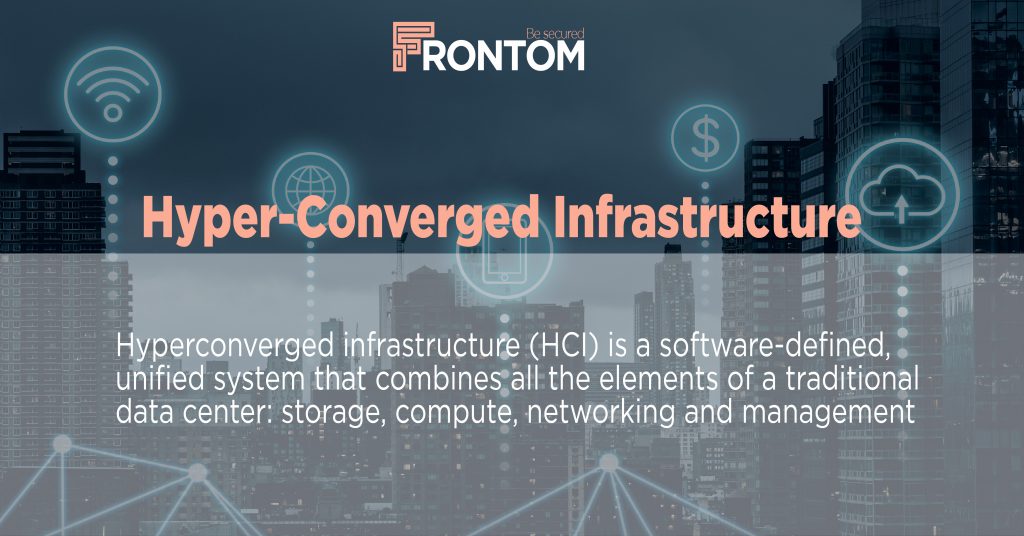To replace the existing servers, storage networks, and storage arrays, servers and storage are merged on a distributed platform supported with intelligent software to provide customized building blocks. Local storage devices (spinning disks or flash) are coupled to commodity server hardware through a distributed software layer, eliminating the critical pain points of previous architecture. Specifically, the hyper-converged network infrastructure may be used to virtualize all of the hardware in a typical data center. The resources of an interconnected infrastructure may be centrally managed using a software-defined architecture.
The word “hyper” in the name is a bit misleading. A hyper-converged system is not better than a converged design (ci). As a result of hyper converged network infrastructure’s capabilities, large, VM-oriented companies may quickly scale up and scale down with the ease of sending an email. Hyperconverged network infrastructure is called “hyper” since software defines everything. Today’s technology is so entwined with the rest of the world that it is difficult to separate its components. So, once you have converted to software, it may be challenging to go back.
Are There Advantages to Hyper Converged Network Infrastructure Over a Regular CI?
For the following reasons, hyper-converged network infrastructure is sometimes seen preferable to a traditionally converged infrastructure:
Setting it up is a snap
It is common for the essential components of a virtualized system to be packaged up and pre-configured as part of an infrastructure solution. These systems must be reconfigured, optimized, and protected to meet the demands of a wide range of workloads.

Straightforward to deal with
Making it easy to buy and upgrade equipment is not enough to fix the underlying infrastructure problems. Users have little participation in managing and integrating infrastructure components using hyper converged network infrastructure.
Flexibility
Flexible services are made possible by VM-centric operations, which protect data from infrastructure failures while also improving availability.
Easier to implement multi-vendor solutions
Various commodity computing, storage, and networking equipment manufacturers are virtualized, software-centric, and integrated into hyper converged network infrastructure. A multi-cloud strategy is now viable in your infrastructure.
Does Your Company Require a Hyper Converged Network Infrastructure?
The cutting-edge technique of hyper-convergence makes it important for all organizations. Instead of relying on a pre-packaged or bundled product, you are welcomed to create your data centers by applying the concepts of virtualization and convergence to individual infrastructure components. Software-defined and virtualized environments can automate federated hardware resource provisioning, administration, and configuration. Through the software, infrastructure resources may be flexibly assigned to different workloads and applications.
Benefits of Hyper Converged Network Infrastructure
The significance of human-computer interaction (hyper converged network infrastructure) may have become evident by now. There are several benefits to using hyper-convergence technology, such as outlined below.
The Merging of Computing Resources
Enterprises may employ hyper converged network infrastructure to replace their current monolithic storage and networking infrastructures with unified infrastructure resources to optimize their data center investments. When data centers are consolidated and automated, the software allows for centralized management. It ultimately reduces managers’ workloads.
Decreases The Network’s Design’s Complexity
This capacity is required for effective infrastructure scaling. More hyper converged network infrastructure nodes may be added to an organization’s system without requiring that each piece of hardware or device be separately configured, secured, and maintained.
Software-Driven Architecture
Workload management tactics are not tied to particular infrastructure hardware components with software-defined infrastructure operations. You will not have to update your policy settings as often since the workload may be transferred between data center storage instances or new hardware can be installed. By design, rules are established and maintained at the program level rather than tied to specific hardware components, thanks to the software-centric architecture. It is possible to employ automation to maintain, protect, and grow the infrastructure in response to changing workload requirements in this software-centric design.
Virtualization Extends Outside the Network
Hyper converged network infrastructure overcomes the limitations of traditional virtualization technologies. Expanding the infrastructure is feasible by adding extra computing, storage, and networking resources. A software-based storage controller allows hyperconverged architecture to employ all of its infrastructure nodes to distribute its storage controller capabilities rather than relying on hardware.
Software-defined storage may be used to tailor a virtualized environment’s whole storage pool. As a result, software-driven storage management may be implemented across the whole infrastructure.
Management That a Single Person Oversees
When it comes to the necessary systems in place, host container infrastructure (hyper converged network infrastructure) offers a centralized management interface for all cluster nodes, whether virtual machines (VM) or containers. You do not require separate management consoles for different hardware or virtualized resources in a converged or standard virtualized infrastructure solution. All of the nodes in the federation share the same infrastructure and data management tasks, which are all controlled via a single unified user interface (UI).
How Does Hyper Converged Network Infrastructure Affect Your Business?
Today’s quickly expanding, networked, and data-driven economy needs an infrastructure that is both agile and scalable so that your products and services can adapt to swiftly changing market demands. A single pane of glass provides its security and management employees with centralized administration and system-wide integration of system resources. These changes will allow it to better respond to changing business needs. Various services, such as infrastructure scale-out and workload mobility, may be managed under a single administrative umbrella to speed up product development.
The obvious next step for many firms is their desire to accomplish significant breakthroughs in their virtualized, converged, and software-driven infrastructures, which includes the implementation of hyper-converged infrastructure.

As the editor of the blog, She curate insightful content that sparks curiosity and fosters learning. With a passion for storytelling and a keen eye for detail, she strive to bring diverse perspectives and engaging narratives to readers, ensuring every piece informs, inspires, and enriches.









